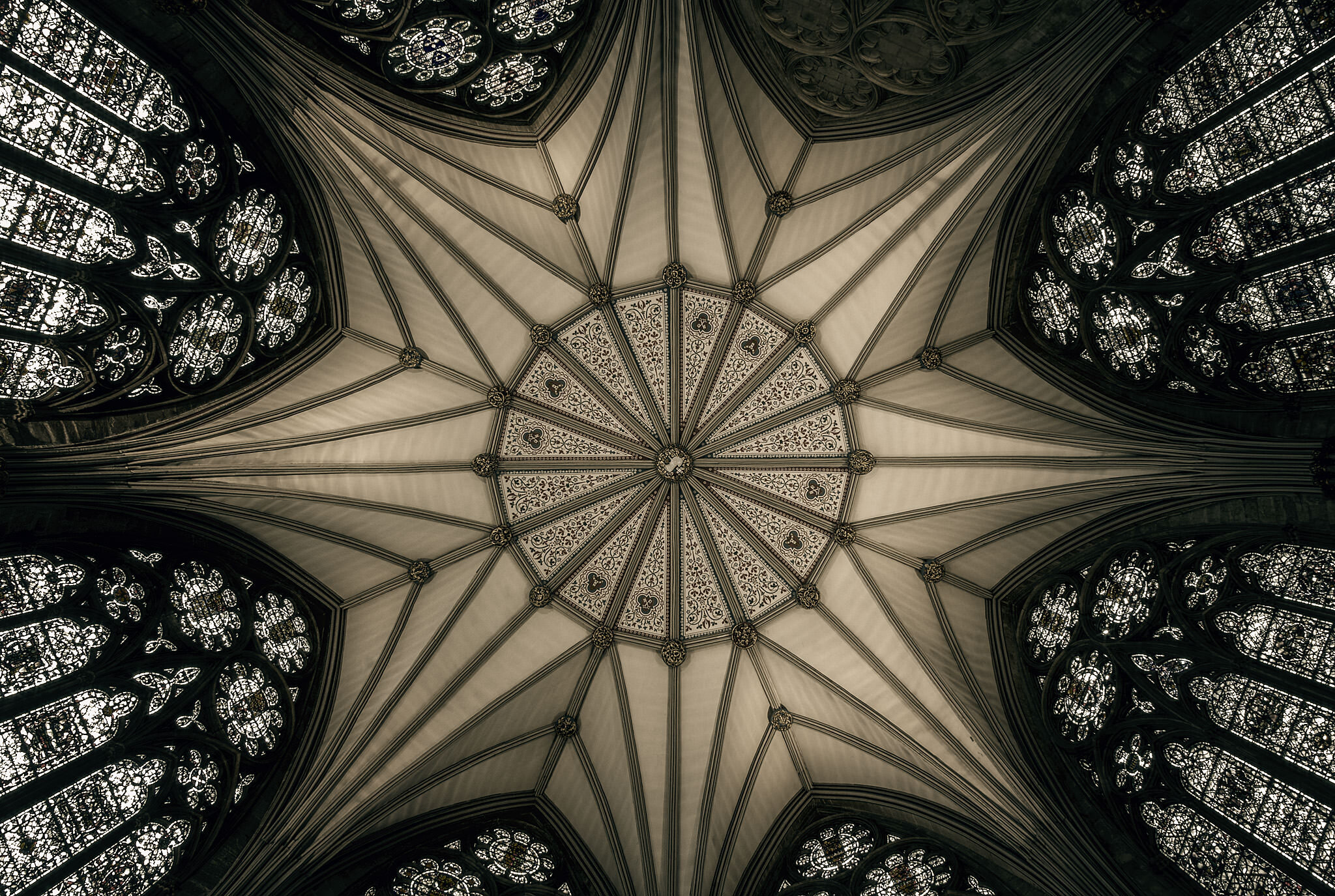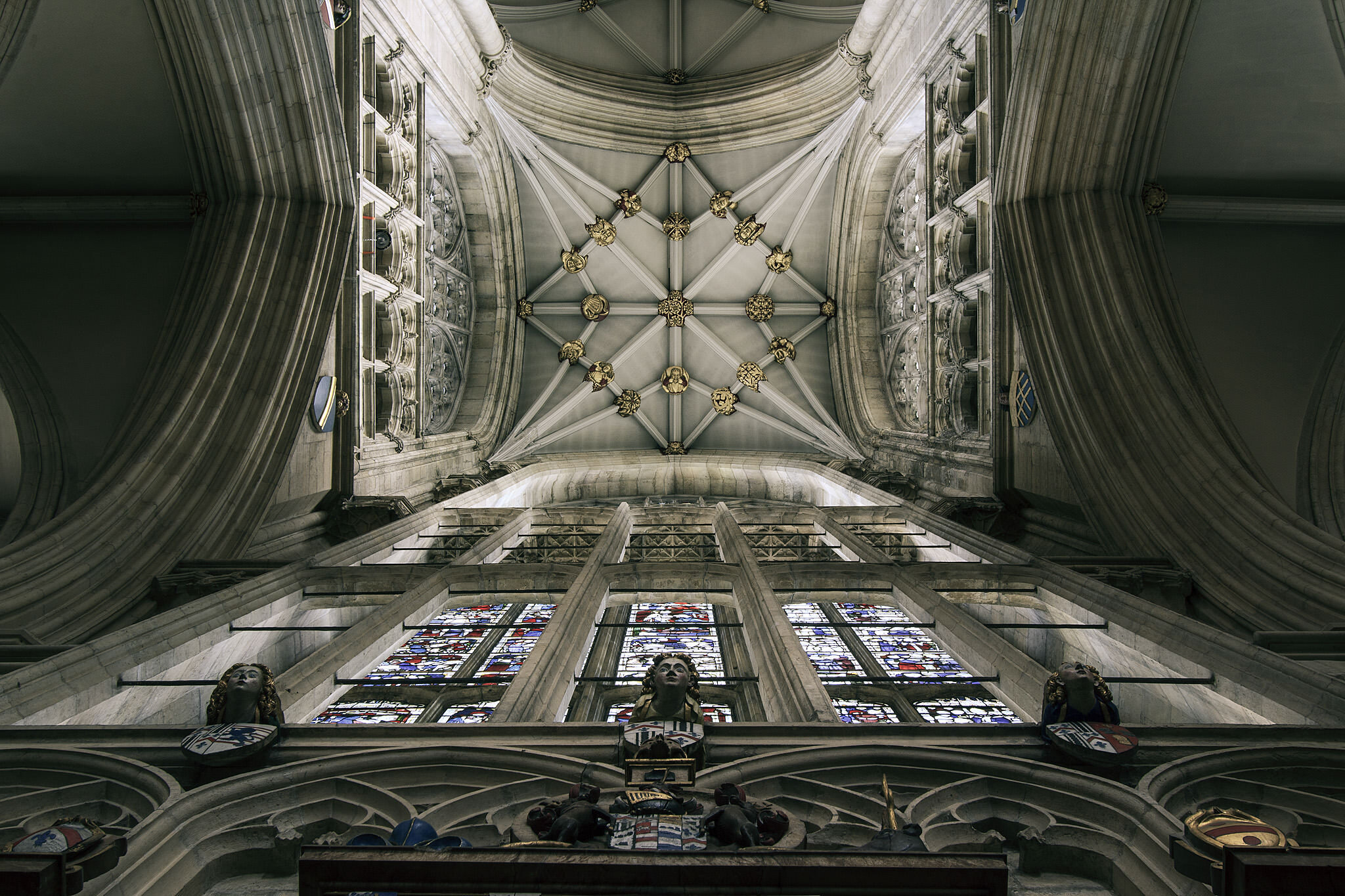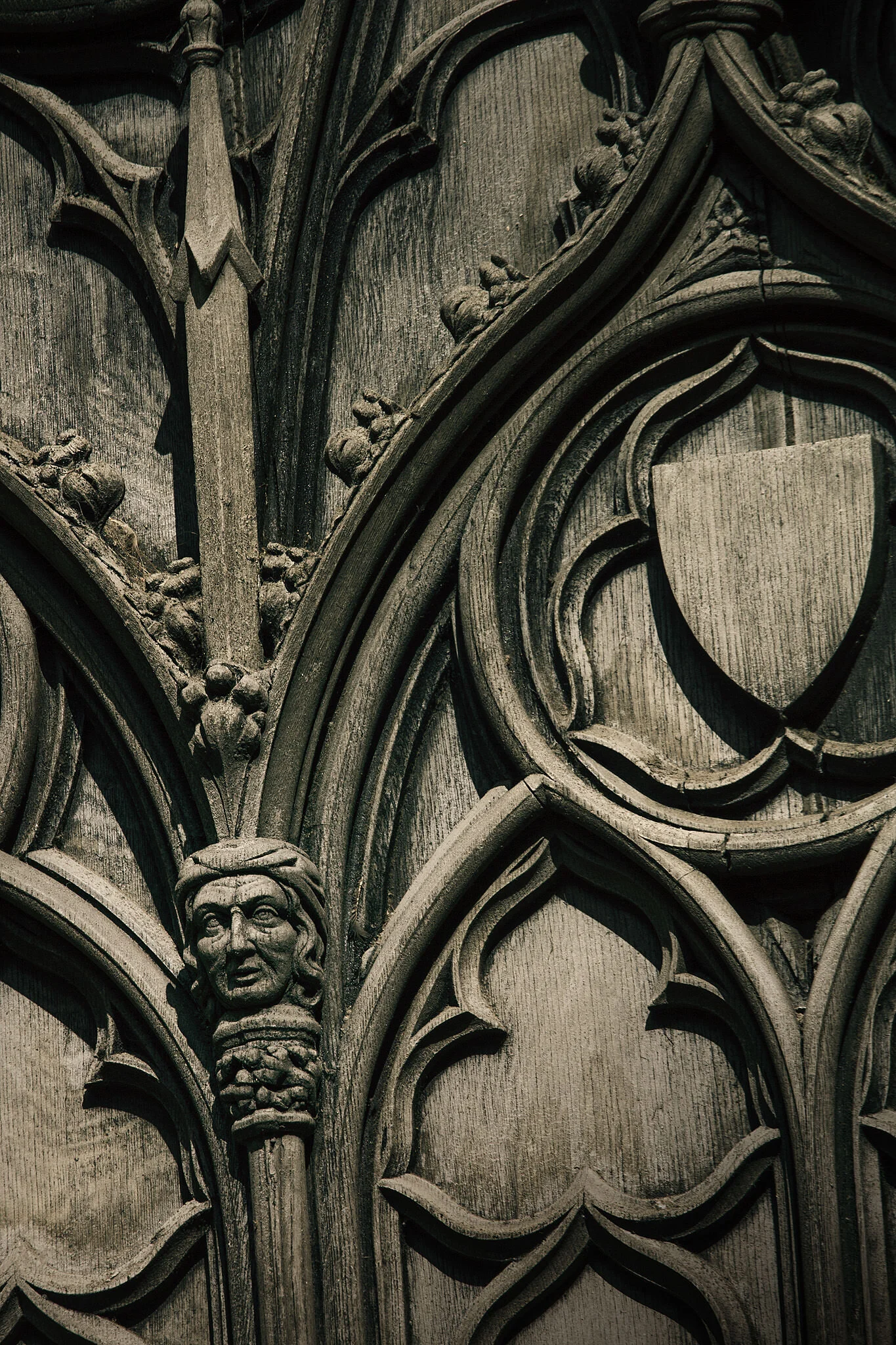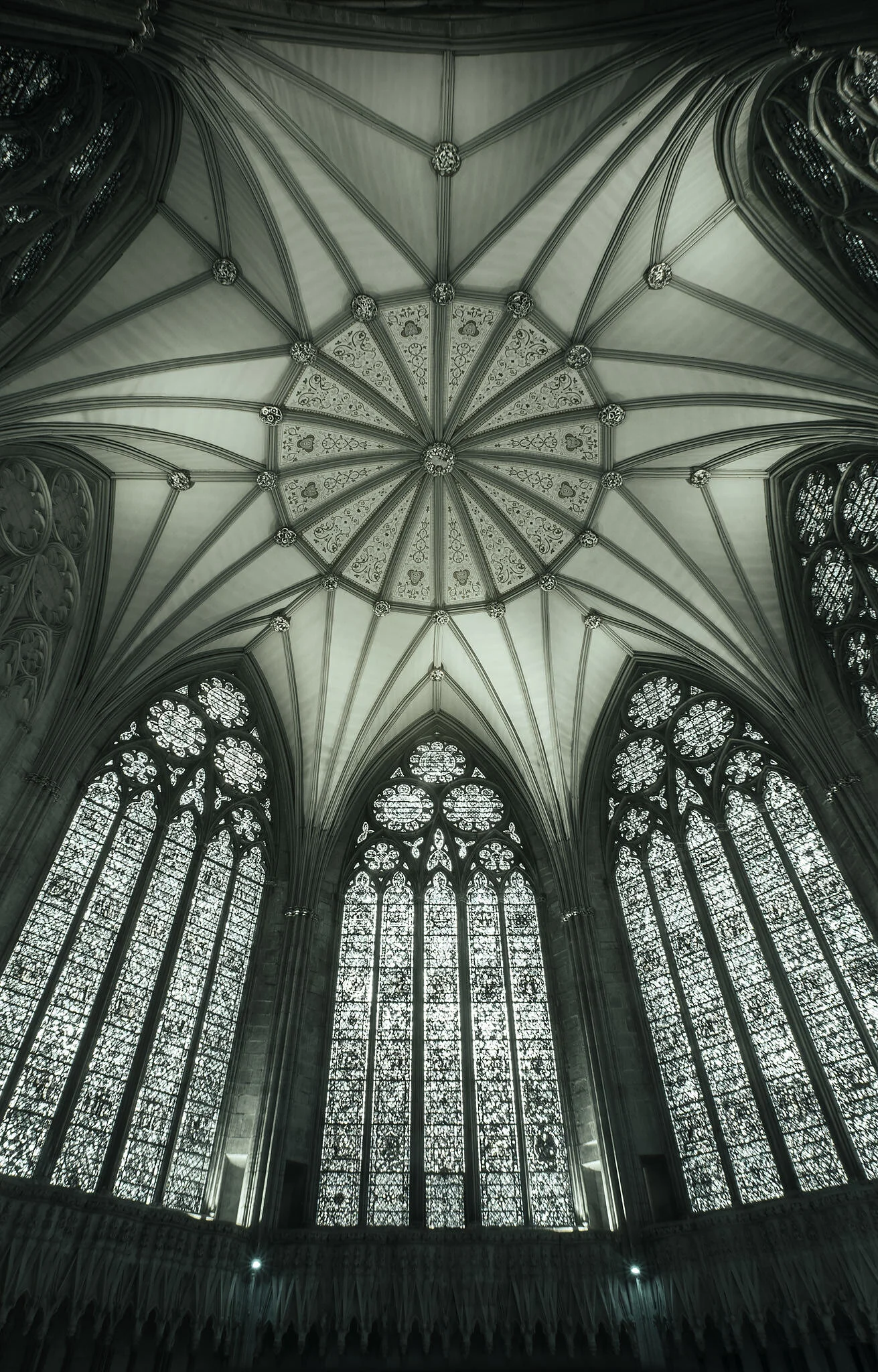York Minster, York










A Statue of Constantine the Great, who in 312, caused Christianity to become one of the permitted religions of the Roman Empire, sits outside York Minster. In 306, Constantine himself was in York. He stayed at a Roman fort, the grounds of which is now part of the Minster. York was the base of the 9th Legion and controlled the north. Constantine was in York when his father died and he was immediately hailed as the next Emperor.
Legend tells us that Christianity was brought to Northern England in 627, through the marriage of the Northumbrian King Edwin and Ethelburga, the daughter of Ethelbert, King of Kent. Ethelburga was a Christian and the marriage contract stated that she should be allowed to practice her religion. She brought to her new home a chaplain, who set about trying to convert King Edwin. Bebe tells us that:
‘the kings baptism took place at York on Easter Day, the 12th of April, in the Church of Saint Peter the Apostle, which the king had built of timber during the time of his instruction and preparation for baptism. Soon after his baptism, he gave the order to built on the same site, a larger and more noble basilica.’
In the Crypt of York Minster, there is a stone font, which stands on the traditional site of Edwin’s baptism. This is thought to be the beginning of York Minster, although nothing remains of this early church and no archaeological evidence has been found.
When Ecgbert was made Archbishop of York in 732, the See became an Archbishopric at this time. Ecgbert expanded both the school and the library . He appointed Master Aethelbert, who succeeded him as Archbishop. Under Aethelbert’s leadership, the school grew and flourished. In 782 the school was so highly regarded that Charlemagne invited Alcuin to become the Master of his own Palace School. Ecgbert left us a description of his church, he states that it:
‘was lofty, the panelled ceiling being supported by columns with rounded arches between. It contained 30 altars, many of which were housed in side chapels.’
Once the Vikings captured York, we have little knowledge of the Minster. We know that in the 10th Century, some of the Danes converted to Christianity and the Minster remained the centre of Christian worship in the area, however it's school and library disappeared. There were two Archbishops from this period, St. Oswald and St. Wulfstan, who both held the See of Worcester, at the same time as holding that of York.
Edward the Confessor governed England by elevating three Earls. He had Godwin in the south, Leofric in the midlands and Siward, a Dane, in the north. Siward governed from York and an area of Bootham, near St. Mary’s Abbey. In an Anglo-Saxon Chronicle, in the year 1055, there is an entry which states:
‘In this year died Earl Siward at York, and he lies at Galmanho in the Minster which he himself had built and consecrated in the name of God and Olaf.’
The Minster has never been a Monastic foundation, even though the word Minster derives from the same source as the word Monastery. It originally referred to any church, which was a mission-station and served by a group of secular clergy living communally.
Following the devastation caused by William the Conqueror’s Harrying of the North, Archbishop Thomas was appointed to York. He had previously been the Treasurer at Bayeux Cathedral in Normandy. What he was handed, was a church that had been burned, ransacked and pillaged by Norman soldiers. Although he initially began repair works, after the last Viking attack on York in 1075, the Minster was left with further damage and he decided to rebuild on the new site.
The Romans had chosen the best and highest ground for their fort, which was now in ruins. This was the spot that Archbishop Thomas chose for the new Minster. By this time, the Roman Fort was probably in a ruinous condition and much of the stone was used as infill between the walls of the new Minster. Archaeologists have excavated under most of the Minster and have discovered the foundations of Thomas’s Cathedral. It was 110 meters long and the design reflected his Norman background, with three semi-circular apses and an aisleless nave.
Having an Archbishop in Canterbury and an Archbishop in York was bound to lead to problems. Canterbury had assumed the Primacy of England and York had been forced to profess obedience to the Archbishop at Canterbury. It was Thomas’s successor, Archbishop Thurstan, who tried to deal with this issue. Pope Gregory had previously visited England and declared that there should be two Archbishops in England, one in the south and one in York and that they should take turns at assuming seniority. The case was taken to Rome for adjudication and we are left an account that tells us, that the monks from Canterbury tried to use forged documents to argue their case. They became the laughing stock of the court when they tried to explain the absence of seals on the documents, the lack of which invalidated them. The Pope found in York’s favor and since then, no Archbishop of York has had to profess obedience to Canterbury.
Archbishop Thurstan’s successor was William Fitzherbert. Fitzherbert was related to King Stephen through his mother, who was Stephen’s half-sister. He was elected as Archbishop in 1141, but he was not universally accepted. Some of the canons refused to accept him and the matter was referred to the Pope. The Pope agreed with the Canons and Fitzherbert was deposed, with Henry Murdac being appointed in his stead. Fitzherbert accepted this and spent a year in Sicily before moving in with his uncle, the Bishop of Winchester. His supporters in York did not accept the Pope’s decision so easily and burned and pillaged Fountains Abbey, forcing the new Archbishop to flee York. In 1153, both Archbishop Henry and the Pope died and Fitzherbert was restored as Archbishop of York.
On William Fitzherbert's return to York, many of the citizens came out to greet him and watch the procession of his triumphant entry into the city. There were so many people on the bridge over the River Ouse, that it caused the structure to collapse under their weight.
It didn’t end well though for Archbishop William. A few months after his return to York, William was thought to have been poisoned. He died after taking ill following early mass. The Archdeacon, Osbert of Richmond, was accused of adding poison to his chalice. The Archdeacon was unable to prove his innocence and was ‘unfrocked’- forced to leave the order. Rather than being punished, he became a minor Baron. William got to become a Martyr, with miracles beginning to take place shortly after his death. By 1223, people were convinced he was a Saint and there is said to have been a sweet smell coming from his tomb. In 1227, he was Canonised and made a Saint, his tomb was moved to a shrine behind the High Altar.
With some haste, the next Archbishop was elected, not from York but from Canterbury. The Archdeacon of Canterbury, Roger of Pont l’Eveque, was elected as Archbishop of York. Roger’s reputation is somewhat tarnished by his arguments with Thomas Becket, who was Archbishop of Canterbury at the time. Roger was accused of stirring events that lead to Becket’s murder, having been a supporter of Henry II’s efforts to take control of the church. He and Becket argued, and there was still a rivalry between York and Canterbury.
Archbishop Roger made great achievements in the rebuilding of the Minster. He re-modelled the choir, building it over the crypt, on large pillars which can still be seen today. He also squared the previously rounded apses and added transepts and an ambulatory, to improve circulation during services. He extended the nave, making it the length we see today. Some of the glass from his windows can still be seen in the upper windows of the nave. He remodelled the west end and added towers and a chapel close, on the north-west side. By the time of his death in 1181, York Minster had become one of greatest Cathedrals in Europe.
Geoffrey Plantagenet was Archbishop of Canterbury from 1189-1212, he was the illegitimate son of Henry II. Geoffrey, like his father, possessed an ability to quarrel with everyone around him. However, he appears to have been one of Henry II’s more loyal children. When his half brother, Richard I was captured, he sent the Cathedral’s treasury as part of his ransom. From 1207 until his death in 1212, he was in exile in Normandy, having objected to King John’s treatment of the church.
The Chapter was in some disarray during the time Archbishop Geoffrey Plantagenet was in exile. It wasn’t until three years after his death, that the next Archbishop was appointed and even then, it took the intervention of the Pope for it to happen. Walter de Gray was seen as a Royal appointee, having been the Chancellor of England, but he was eventually accepted as the next Archbishop of York. His time was successful and he worked to reform the administration.
De Gray was Archbishop of York from 1215-1255 and during this time, he decided that the cathedral should be rebuilt in the new Gothic style. The south transept was completed in his lifetime, this was the first phase of the building project, which would take another 200 years to complete. One of the most difficult tasks of building a Cathedral wasn’t finding the people to build it, it was finding the materials to built it with. There was no 'builders yard' to buy this from, De Gray needed to find landowners who would support him. Robert Vavasour granted rights to quarry stone for the Minster at Tadcaster, and the Percy family contributed oaks for the construction of the roof.
Many of the coats of arms that can be seen in the stone and glasswork at the Minster, are the result of a family donation of funds, which were given towards the building of the Minster, with the monetary gift being rewarded by the inclusion of the family’s coat of arms. Where the coat of arms appeared and how nicely it was represented, was directly related to how much money was given.
The first Royal Wedding to occur at York Minster was in 1251, when Henry III’s daughter Margaret, was married to Alexander III of Scotland. Hosting the wedding cost Archbishop Walter four thousand marks, having donated 60 oxen for the feast.
It was during de Grey’s time as Archbishop, that the problem of Canon’s not being present and living elsewhere, was addressed. From 1212, it was decided that they would be required to live near the Minster for a minimum of half the year. The residentiary Canon was expected to attend Matins, Vespers and the major celebrations of Mass, unless prevented by illness. York was one of five English secular cathedrals, in which the prospective Canon had to give edivence of his intent to reside in the precinct, before he would be entitled to recive emolument (money), from the Chapter’s common fund. The amount to be received by each residentiary was fixed at a rate of 6d a day, a good living at the time. The fact that this needed to be written down and agreed to, indicated that many Canon’s were not present previously, did little for the chapter, yet still were able to be paid.
When Archbishop de Grey died in 1251, he was buried in the newly built south transept. During restoration of the tomb, it was discovered that the inside of the coffin lid had a painting, which depicted the Archbishop in full Canonical robes. He had also been buried with his archiepiscopal ring, pectoral cross and crosier (staff) as well as a chalice and paten (small plate). These artefacts are now housed in the treasury.
Another source of funds for the rebuilding of York Minster, came from pilgrims. The shrine of St. William, who had previously been an Archbishop of York, was built in 1284 and William's tomb was moved to this new location behind the altar. Edward I was present and helped to carry the coffin of the Saint from its original burial site. The body was re-buried except for the head. This was placed in a silver-gilded reliquary, studded with jewels and kept apart, so that it could be brought out for special occasions. This new shrine brought in vast funds for the Chapter.
The governing body of a Cathedral is known as the Chapter. Every Cathedral also needed a Chapter House where the Chapter could meet. It would be the one part of a Cathedral that would not be consecrated. Many Chapter Houses have not survived, as once the chapters were abolished (albeit temporarily), Chapter Houses were no longer needed. At York however, the Chapter House does survive but it was a close thing. Permission was granted by the council for its demolition, however the owner at the time died before it could be demolished.
The Dean would lead Chapter meetings and the Archbishop would not attend, unless he was requested to do so. The reason for this was that the Dean was meant to be the 'first among equals', he was in charge of the Chapter and the Cathedral’s clergy. Interestingly, when the Dean went out on business, he could be accompanied by 19 horses, whereas other Canons were restricted to being accompanied by 5 horses and an entourage of 80. These were wealthy and important men at this time.
In the Middle Ages, the number of clergy comprising the Chapter at York was 36.They were some of the best paid clergy in the country, with their annual income in 1291 being £48. Seats on the Chapter at York were hard to come by, and they were often given to relatives of Bishops and Kings.
The Chapter House at York was started in 1260, once the north transept was completed. It was finished and in use by 1286. Its octagonal shape is more than 19 meters (62.3 feet) wide and 20 meters (65.6 feet) tall, making it the largest in England.
The Chapter House also contains a series of 237 heads, carvings of everything from animals to monsters, some are original and others were replaced in the 19th Century. The stained glass windows are contemporary, all but one, and date from between 1300-1310. The ceiling was replaced in 1798 and the central column removed.
On the 6th of April 1291, York's Archbishop, John le Romeyn, laid the foundation stone of the new nave. At this time, this was all that was left of Archbishop Thomas’ Cathedral. The new nave would take 70 years to complete, due to its immense size, and the sourcing of materials. One of the additions of the new nave were aisles. These allowed the width to be double that of the old nave, making it the widest nave in England. Of course this brought with it some structural issues and it was worried that the walls would not be strong enough to bear the weight of the roof, so it was decided that the roof would be made of wood, rather than being stone vaulted.
Bishop Melton was Archbishop at York when the west front was being built. It was under his direction that the heart shaped window, known locally as ‘the heart of York’, was built. 600 years of weathering later, the stonework had become damaged beyond repair. In the 1990's major restoration was necessary and the entire window was re-carved, with the original glass being re-used.
On the 6th of February 1349, a group of supporters of the Bishop of Durham entered the Minster to demonstrate against the authority of the Metropolitan Church of York. They stood at the gates of the choir and expressed their contempt for the clergy of York, by shouting insults and ‘performing other enormities’. While we don’t know what provoked this particular demonstration, it does show there was animosity between the Chapters of York and Durham.
When Henry IV took the throne from Richard II, Richard Scrope was the Archbishop of York. In 1405, there was an uprising in the north against the King. This was a serious threat to the King, one of the leading participants was Archbishop Scrope, along with the Earl of Northumberland, the Earl Marshal and Lord Bardolf. The Archbishop was deeply involved- he openly supported the traitors and preached against the King in the Minster. In May of 1405, the Archbishop lead an army of 8,000 men against the royalist army. On Shipton Moor, it is believed that Scrope was to meet reinforcements from the north, but they did not arrive. Scrope disbanded his force in an attempt to procure a truce but he was immediately arrested. Henry IV travelled to York for the trial, where the Archbishop was found guilty of treason and sentenced to be executed by beheading. The Archbishop was paraded through the streets of York, while sitting backwards on a mule. The King allowed Scrope's body to be buried in York Minster but no effigy was allowed. His head however, sat on a spike on Bootham Bar for months.
In 1407, the central tower collapsed. This seems to have been a very common theme with church towers. They had been rebuilding all around it for a couple of hundred years and it would probably have been replaced eventually, but this suddenly became urgent. Two letters survive giving the reason for the tower’s collapse. One was written to the Pope, who was told that it was due to a ‘horrible tempest’, the other was written to the King, which said it was due to ‘the carelessness of the masons.’
The tower was re-built, with the surrounding arches taking the weight of some 16,000 tons of stone. Beautiful as it is, it is much shorter than originally planned. During the building work, there was a major structural weakness which, although they attempted to strengthen it, was still likely to cause the tower to collapse. The foundations were strengthened and the movement was stopped but so was their ability to build higher.
The current Lantern Tower was built in Perpendicular style and planned by the Royal Architect, William of Colchester. The carved bosses are not just decorative, they are structural, and lock the oak ribs of the vaulting into place. To give a sense of scale, the central boss of the Lantern Tower is 1.5 meters (5 feet) across.
York Minster’s Great East Window was originally installed into the Minster in the early 15th Century. It is the largest expanse of medieval glass in England. It contains 311 panels and is comparable in size to a tennis court. The panels represent the beginning and end of all things. The window became very fragile and was in desperate need of restoration. The York Glaziers Trust had the task of restoring the window, which involved the conservation or replacement of nearly 2,500 stones, which were the work of York Minster’s stonemasons. The project ran from 2011 to 2018 and the window is now back in place and preserved for many more years to come.
In the 15th Century, the popularity of Chantry Chapels was at its peak. York Minster had 60 Chantry Altars and special housing was provided for the priests who serviced them, with the building of St. William’s College, at the eastern end of the Cathedral Precincts.
The Minister was finally finished and re-consecrated in 1472. It wasn’t too long afterwards, that things deteriorated at the Minster. A report was made for the Dean in 1519, by the Vicars Choral and the Chantry Priests, which described the condition of the Cathedral as being in need of a good spring clean. It was reported that dust and cobwebs hung from the wall and pillars, altar coverings were ragged and torn and the hangings of the choir lay neglected in the vestry, covered in dog dirt and candle wax.
The wooden roof that covered the wide nave was destroyed by fire on the 20th of May in 1840. A man had been called in to repair a clock and had left a candle burning. It was not until late in the evening that the flames were spotted. Help was called in but there was nothing to be done. The bells crashed to the floor, one by one, as the roof timbers burned. The medieval roof was gone but detail drawings allowed for its replacement to be a copy of the original.
In 1984, York Minster was once again on fire. The official report stated that lightning had hit the roof timbers in the south transept. There was a great fear that it would spread to other roof areas, and so the remaining timbers were pulled down to create a fire break. As a result, the central tower was not affected, but the roof of the south transept was completely destroyed. The rose window had over 40,000 heat cracks in it and would need extensive restoration.
Even today, York Minster still has a masons yard outside its doors. It is their responsibility to shape by hand, the blocks of stone, into useable pieces for the work at the Cathedral. All the work is done with mallets and chisels, just as it was meant to be.
The amount of organisations that masons working on the Minster need to deal with to change anything, also can’t be easy. The Minster has an advisory board of architects, engineers and accountants- they need to know the reasons and see the proposals, for each stone that is replaced. Every decision is scrutinised and above the advisory board, is the Cathedral’s Fabric Commission, then there is English Heritage and the Society for the Protection of Ancient Buildings, who also have to have their say. Its amazing that the restoration work is able to go on at all, considering the 'red tape' it needs to get through. In all of this, there is the hope that the Minster will get the very best conservation.
Today, the masons at York also train apprentices. This vital craft needs to be sustained and only through investing in the next generation can it be kept alive. Apprentices spend four years training to become qualified masons. The Minster is part of a national network, called the Cathedrals Workshop Fellowship, which works to support the development of craft skills, for the purpose of conservation, maintenance and repair of Cathedrals and historic buildings.

































